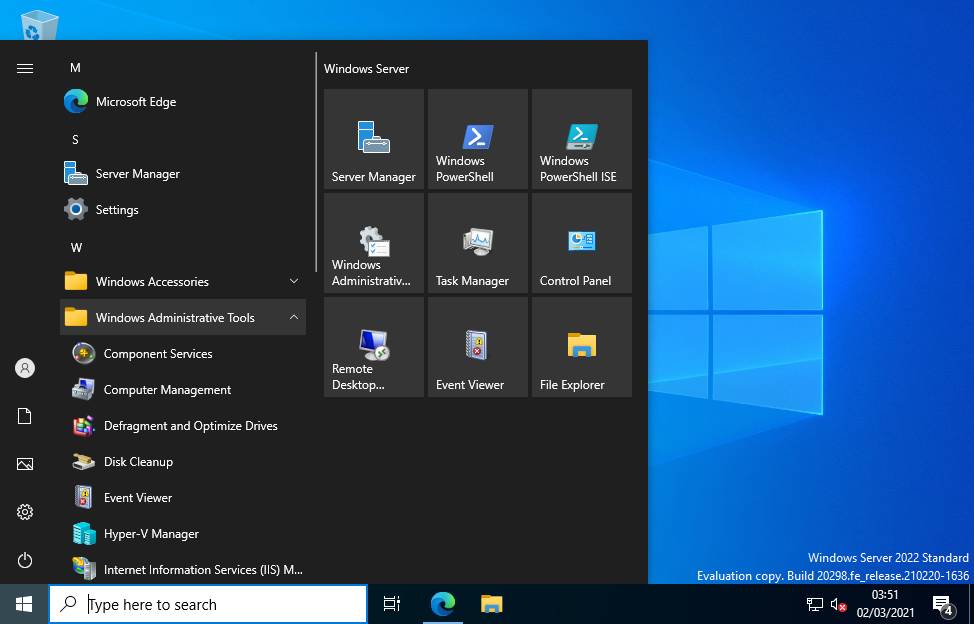
Windows Server 2023 Build 20348.230 Crack + Keygen Code Free Download
WINDOWS SERVER 2023 Build 20348.230 Crack is the latest version of the Server Operating System by Microsoft.it is part of the Windows NT family of the operating system. It was announced on March 20, 2020. The first windows Insider preview version was also released on March 20, 2020. It refers to any of the server instances that are installed and operated by the windows server family of the operating system and it has advanced multilayer security.
WINDOWS SERVER Patch (with many people putting a focus on cloud computing), like an updated version of Hyper V, an IP address management role, a brand new variant of Windows Task Manager, and Reefs, a brand new file system. There usually received excellent ratings despite having integrated the same debatable Metro-based pc user interface observed in Windows 8. The successor to Windows Server product Key, called Windows Server 2020 R2, was launched along with Windows 8.1 in October 2020.
WINDOWS SERVER Crack
It is part of the windows server family including windows 2000 server, windows server 2003, windows server 2008, windows server, and Windows as well. It has a very smart outlook and a user-friendly graphical user interface.
Windows Server Free Download is the operating system that has an additional layer of security and allows you, you can standardize and modernize as you want. It elevates your security posture by protecting the data center. It is released by Microsoft. It includes all the operating systems that are branded Windows Server but not any other Microsoft product.
It has a feature of Active Directory Federation Services which is possible to configure AD FS to authenticate users stored for example such as x compliant. Windows server antimalware is installed and enabled by the default of the graphical user interface. In this version cluster, the operating system rolling is upgraded.

Key Features of Windows Server
- New layers of security built into Windows Serve will help prevent malicious attacks, detect suspicious activity, protect virtual machines, reduce risks, and protect the platform against new threats.
- New deployment options with Nano Server: an updated module for image building, separation of the physical and guest hosts of the virtual machine, and support for various editions of Windows Server.
- A wide range of high-performance and cost-effective storage options with an emphasis on sustainability cost reduction and increased control.
- Windows Server 2020 provides optimization of the already acquired storage infrastructure modules, and creates affordable, high-performance, and scalable solutions.
- Create and run, deploy, and track applications in both the cloud and local environments.
- Expand the capabilities of users through secure access, from their preferred devices to corporate resources.
- Virtual machines can be configured with significantly more memory and virtual processors than in previous versions of Windows Server.
- Nested virtualization allows you to use the virtual machine as a Hyper-V host and create virtual machines within this virtualized host. This can be very valuable for the development and testing environments.
- The new network stack contains the basic set of network capabilities and the SDN architecture that has migrated from Azure to the data centers.
- Windows PowerShell‘s delegated administration technology includes support for network authentication, PowerShell Direct connections, secure file copy, and console configuration.
- New kernel-based licensing model: To license a physical server, you must license all physical cores. At least 8 licenses are required for each physical processor on the server.
Information Deduplication:
Software Inventory Logging:
iSCSI Target Server, The iSCSI Target Server API, supplies Windows Management Instrumentation (WMI) providers for dealing with the Microsoft iSCSI Target Server, like creating virtual disks, and also for presenting them to the client. Some new features had included in this program.
What is New In Windows Server 2023
- Hybrid work scenarios: Windows Server 2023 is designed to support hybrid work scenarios, allowing users to work from anywhere securely and efficiently. It is expected to offer advanced capabilities for identity, security, and networking that will enable organizations to manage and secure remote work environments more effectively.
- Improved security features: Windows Server 2023 is expected to include enhanced security features, such as the ability to manage security policies and controls from a central location, to ensure that security policies are applied consistently across the enterprise.
- Support for containers and microservices: Windows Server 2023 is expected to provide enhanced support for containers and microservices, making it easier for developers to build, deploy, and manage cloud-native applications.
- Enhanced performance: Windows Server 2023 is expected to offer improved performance and scalability, enabling organizations to handle the increasing demands of their workloads.
- New management and automation tools: Windows Server 2023 is expected to include new management and automation tools to streamline administration and reduce costs.
Pros:
- Integration with Microsoft ecosystem: Windows Server integrates well with other Microsoft products, such as Active Directory and Microsoft Exchange, making it easier for organizations to manage their IT infrastructure.
- Familiar interface: For organizations that are already using the Windows operating system, Windows Server offers a familiar interface, which can reduce training costs and increase productivity.
- High availability and reliability: Windows Server is known for its high availability and reliability, which is critical for mission-critical applications that require continuous uptime.
- Strong security features: Windows Server includes robust security features, such as Windows Defender, which can help protect against malware and other security threats.
- Flexible licensing: Microsoft offers a variety of licensing options for Windows Server, including per-core licensing and subscription-based licensing, which can make it easier for organizations to manage costs.
Cons:
- Cost: Windows Server can be expensive, especially for organizations that require a large number of licenses or that need to run it on multiple servers.
- Complex installation and configuration: Installing and Configuring Windows Server can be a complex process, requiring specialized skills and expertise.
- High resource requirements: Windows Server can be resource-intensive, requiring powerful hardware to run efficiently, which can add to the overall cost.
- Limited interoperability: While Windows Server integrates well with other Microsoft products, it may not be as compatible with non-Microsoft products, which can limit interoperability with other systems.
- Steep learning curve: Because Windows Server is a complex system, it can have a steep learning curve, which can make it difficult for administrators who are not familiar with Windows Server to manage effectively.
How To Use Windows Server
- Choose the right version: There are several versions of Windows Server available, each with different features and licensing options. Choose the version that best meets your organization’s needs.
- Install Windows Server: Once you have chosen the appropriate version, install Windows Server on your server hardware. This process may vary depending on your hardware and installation media.
- Configure Windows Server: After installation, you’ll need to configure Windows Server. This includes setting up user accounts and configuring security and network settings.
- Install and configure server roles and features: Windows Server can be used to host a variety of server roles and features, such as Active Directory, DNS, and DHCP. Install the roles and features that your organization needs and configure them as necessary.
- Manage and monitor your server: Windows Server includes a variety of management tools that you can use to manage and monitor your server. Use these tools to monitor system performance, troubleshoot issues, and manage users and resources.
- Keep Windows Server up to date: Microsoft releases regular updates and security patches for Windows Server. Make sure that you keep your server up to date with the latest updates and patches to ensure that it remains secure and stable.
User Interface Of Windows Server
- Start menu: The Start menu in Windows Server is similar to that of Windows 10, providing quick access to commonly used applications and settings.
- Taskbar: The taskbar is located at the bottom of the screen and provides quick access to running applications and system notifications.
- File Explorer: File Explorer is used to navigating the file system and manage files and folders.
- Server Manager: Server Manager is a tool that is used to manage server roles and features, as well as perform other administrative tasks.
- Control Panel: The Control Panel is used to configure system settings and manage hardware and software.
- PowerShell: PowerShell is a command-line shell and scripting language that can be used to automate administrative tasks.
User Benefits
- Centralized management: Windows Server provides a centralized management platform for IT administrators to manage servers, applications, and users, making it easier to manage complex IT environments.
- High availability: Windows Server includes features such as clustering and failover, which can help ensure high availability for critical applications and services.
- Security: Windows Server includes advanced security features, such as Windows Defender, that help protect against malware and other security threats.
- Collaboration: Windows Server includes features such as SharePoint and Skype for Business, which can help users collaborate more effectively and communicate with each other in real time.
- Access to shared resources: Windows Server allows users to access shared resources such as files, printers, and applications, making it easier to collaborate and work together.
- Remote access: Windows Server includes features such as Remote Desktop, which allows users to access their work computer from a remote location, making it easier to work from home or while traveling.
- Scalability: Windows Server can be scaled up or down depending on the needs of the organization, making it suitable for small businesses as well as large enterprises.
- Compatibility: Windows Server is compatible with a wide range of hardware and software, making it easier to integrate with existing IT systems.
How to Crack:
- First of all download the Trial version.
- Then download the Crack file and key.
- Then turn off the internet connection.
- Install it.
- Run it and enjoy it.
System Requirements:
- Processor: 1.4 GHz 64-bit processor.
- RAM: 512 MB.
- Disk Space: 32 GB.
- Network: Gigabit (10/100/1000baseT) Ethernet adapter.
- Optical Storage: DVD drive (if installing the OS from DVD media)
- Video: Super VGA (1024 x 768) or higher resolution (optional)
- Input Devices: Keyboard and mouse (optional)
WINDOWS SERVER Serial Key
- SDFGH-TRE-ERTH-YJ-TRD-FG-DFG-HYT-RE-R-FD
- SDFGT-FDS-DFGT-RERT-HR-EDSDF-GDS-XS-DXC
- CVBN-FDSSA-DFCVB-DSAER-TYUYTRED-XCVBGF
- SDFGYHU-YTY6RT5RE-DFGF-DSXCV-GCFD-FDGD
WINDOWS SERVER License Key
- ZXCVBFDS-DV-CFDGF-HYRTRWE-GFDS-XVGFRE
- ZXDCFVGB-FREWQ-AFGHG-FEWQ-ASDSD-SFW
- SDFGHJ-YTGRE-DFGH-JGTRE-FGHJ-HGFDSD-FG
https://www.youtube.com/watch?v=VF6vRfOsJ0A
Conclusion
Windows Server Crack is a powerful and versatile operating system designed for organizations of all sizes. It provides a centralized platform for managing servers, applications, and users, and includes advanced security features to protect against malware and other security threats. Windows Server also offers features such as clustering, failover, and remote access, which can help ensure high availability and improve productivity. Additionally, Windows Server is compatible with a wide range of hardware and software, making it easy to integrate with existing IT systems. While there may be a learning curve when it comes to using Windows Server, the benefits it offers are well worth the investment. Ultimately, Windows Server can help organizations achieve greater efficiency, productivity, and security, making it an essential tool for any organization that relies on IT to achieve its goals.
Download Link—->Windows Server
FAQs
- What is Windows Server?
- Windows Server is a powerful operating system designed for server environments. It provides a centralized platform for managing servers, applications, and users, and includes advanced security features to protect against malware and other security threats.
- What are some of the key features of Windows Server?
- Some of the key features of Windows Server include centralized management, high availability, security, collaboration, access to shared resources, remote access, scalability, and compatibility.
- How is Windows Server different from Windows 10?
- While both Windows Server and Windows 10 are developed by Microsoft, they are designed for different purposes. Windows 10 is designed for personal use, while Windows Server is designed for server environments. Windows Server includes features and tools specifically designed for managing servers, applications, and users.
- What are some common server roles that can be installed on Windows Server?
- Windows Server can be used to host a variety of server roles, including Active Directory, DNS, DHCP, file and print services, web services, and database services.
- How can I manage Windows Server remotely?
- Windows Server can be managed remotely using Remote Desktop, which allows administrators to manage the server using a remote desktop connection. Windows Server also includes tools such as Server Manager and PowerShell that can be used to manage the server from a remote location.
- What are some best practices for using Windows Server?
- Some best practices for using Windows Server include regularly updating the operating system and software, regularly backing up data, securing the server with strong passwords and firewalls, and limiting access to sensitive data and resources.
- What are the licensing options for Windows Server?
-
Windows Server is available under several licensing options, including Standard, Datacenter, and Essentials. Licensing options may vary depending on the version of Windows Server and the needs of the organization. It is recommended to consult official documentation or a licensing expert for guidance on the best licensing option for your organization.





